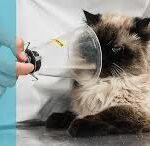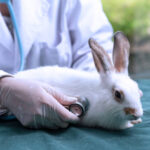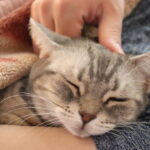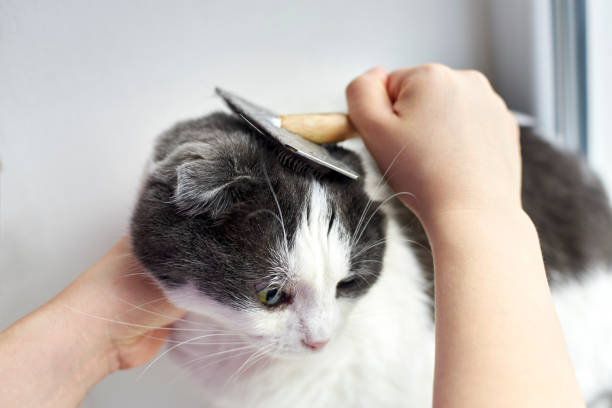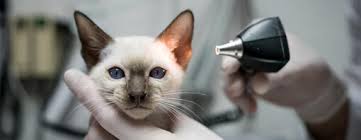Discovering a bald spot or missing fur on your cat can perplex and concern any cat parent. Changing your cat’s coat could be nothing but a red flag of behavioral issues or medical problems. Understanding the underlying cause is the first step to addressing the problem.
In this post, we explore the mystery of cat alopecia, including possible explanations for cat hair loss, what you should do if you notice your cat has a bald spot, and how to prevent this problem from happening.
6 Reasons Your Cat May Have a Bald Spot
The first step to addressing your cat’s hair loss is to identify why it occurred. This will mean paying careful attention to other signs and symptoms, both physical and behavioral. Here are a few of the most common causes of significant hair loss in cats:
Allergies and Irritation:

Does your cat suffer from food allergies or environmental allergies? While most allergies won’t directly cause your cat’s hair to fall out, they trigger dry, itchy skin. As your cat scratches the area, trying to soothe the itch, they may damage the skin or hair follicles.
Identifying the allergens can be difficult. You can do allergy testing or try an elimination diet. But the good news is that once you know the trigger, eliminating it will solve the problem.
Overgrooming:

Cats are well-known for their careful attention to grooming needs, licking themselves to keep their fur clean and shiny. However, there are some behavioral situations when a cat may start grooming excessively, causing damage to their coat or their skin, resulting in bald patches.
The most common causes of overgrooming are stress and anxiety. Take a moment to reconsider your household and any recent changes that may have occurred. Did you move? Are you renovating your home? Did you add a new pet or family member to the household?
Another potential behavioral explanation for overgrooming is obsessive-compulsive disorder. This may have started as stress or anxiety, or it may be genetic. OCD in cats could result from neurological conditions or other medical problems.
Fleas and Flea Allergy Dermatitis:

It is no shocker to any cat parent that fleas are an unwanted pest and an unpleasant experience for our cats. But you may not realize that a flea infestation can also lead to bald spots on your cat. This is because fleas bite, causing itchiness and irritation. Like the situations mentioned above, this triggers scratching and overgrooming to relieve irritation.
Unfortunately, this struggle is even worse for cats with flea allergy dermatitis. An all-too-common condition in cats, this is an allergic reaction to antigens in flea saliva. When the fleas bite, the allergen is introduced, and your cat, in turn, experiences an uncomfortable response.
Of course, the best solution is preventing your cat from encountering fleas. However, this isn’t always possible. If you are dealing with a flea infestation, you want to relieve your cat’s discomfort as quickly as possible.
Fungal Infections:

Your cat may suffer from a fungal infection, irritating the skin and causing hair loss. One of the most common examples of felines is ringworm.
The signs of ringworm include redness of the skin, dandruff, raised lesions, discharge, crusty stores, and, of course, hair loss. While the name consists of “worm,” no worms are involved. Instead, it is caused by your cat encountering the fungal spores by touching an infected animal or object. The spores can live for up to 18 months on objects in the right conditions, meaning you may not know your cat has been exposed until the infection surfaces.
Ringworms are far less common in indoor cats due to their limited exposure. However, if you take your cat outdoors hiking and camping or bring them to public spaces like boarding facilities, groomers, or even to visit their favorite pet store, there is a chance they will become infected.
It’s important to note that not only is this uncomfortable for your cat, but it is also potentially transmissible to you and the other members of your family. Quarantine your cat at the first sign of trouble, contact your veterinarian for instructions, and carefully sanitize the areas of the home where your cat has been. Wear gloves, if possible, when handling an infected cat, and always wash your hands thoroughly after.
Hyperthyroidism or Hypothyroidism:
Many cats suffer from either Hyperthyroidism (an overactive thyroid) or Hypothyroidism (an underactive thyroid).
Cats that suffer from problems with their thyroid often experience a change in the overall quality of their fur. For some, it becomes greasy, dull, or easily matted. For others, however, the coat may be damaged to the point that it starts to fall out, causing a bald patch to form.
Other common symptoms of thyroid issues include:
- Nausea and vomiting
- Diarrhea
- Increased thirst and urination
- “Accidents” outside the litterbox
- Panting or difficulty breathing
- Rapid heart rate
- Restlessness or hyperactivity
- Uncharacteristic aggression
- Weakness
If you notice any of these signs, contact your veterinarian. Thyroid problems can be managed with medical care. This may include dietary changes, medication, or even surgery. Failure to treat the condition can lead to severe or fatal heart problems.
Other Injuries:

Has your cat recently suffered a cut, scrape, or bite from another cat? If so, there is a chance that they suffered a skin injury that, in turn, led to hair loss. Check the area closely, as this could indicate they are dealing with an infection. If the injury is severe and results in a lot of scarring, there is a chance that the hair will not grow back entirely in that area.
Should I Be Concerned if My Cat Has a Bald Spot?
If you have recently noticed a bald spot on your cat, try not to jump to worst-case scenario thinking. We understand that it’s easy to go there, as we all love our cats, but freaking out will not address the problem or provide a solution. Instead, it would help if you focused on identifying the cause.
For those dealing with a flea infestation or significant life change causing stress, this could be quickly addressed at home. But this isn’t always the case.
Contact your veterinarian if the cause of your cat’s hair loss isn’t apparent. There is the potential that this could be a red flag of a severe underlying medical problem that requires their attention. Your vet will run the tests necessary to pinpoint the root cause and establish a treatment plan to set you and your cat up for success.
Follow your vet’s recommendations carefully. This may include oral medications, topical creams, medicated shampoos, or lifestyle changes to address behavioral issues. Pay careful attention to the bald spot for signs of trouble, like if it continues to grow or if you notice further skin irritation. Call your vet if you have any concerns.
Will Bald Spots on Cats Grow Back?

The good news is that in almost all cases of hair loss, your cat’s hair will grow back when the underlying problem is addressed. In some situations, this may require ongoing treatment to ensure that a medical condition is appropriately managed or that your cat doesn’t return to problem behavior. With time, patience, and ongoing care, your cat will soon look like their old self again.
How Can I Treat My Cat’s Hair Loss at Home?
The first thing you should do when faced with cat alopecia is contact your veterinarian. While many of these conditions can be treated at home, the more severe problems will require medical intervention. However, even if your cat is undergoing treatment, many of these suggestions can be used to help support their health as part of their overall treatment plan. Talk to your vet about which options will be safe and effective for your cat.
Create a Stress-Free Home Environment:
Unfortunately, we can’t eliminate all potential stress in a cat’s life. But there are steps we can take to reduce stress and provide the best quality of life for our furry friends.
First, ensure your cat has safe places to perch or hide. In the wild, these locations would be sought out as a way to hide from potential predators, monitor their environment, and spot prey. Our domesticated cats may not have to protect themselves from coyotes, owls, or other wild predators, but they still have the instinctual need to keep themselves safe. If your cat feels like they are exposed or can’t get away from trouble, it can cause unnecessary stress and anxiety.
Adding a cat tree or shelving to your home is an easy way to incorporate this. Even cardboard boxes can be used to create a safe place to hide.
Consider Other Pets in the Home:
Even if your dog and cat have a great relationship, like our crew does (we have three dogs and two cats in the home, all of which are friends), that doesn’t mean there won’t be times that they irritate one another or stress one another out. The secret to maintaining this good relationship is providing them with ways to escape from one another at times.
We found the best way to address this problem was to designate one room as the “cat room” and make it inaccessible to the dogs. In our home, it’s a spare bedroom. We use a Carlson Pet Products Walk-Through Pet Gate to make this easy. The gate blocks the room from the dogs, but a small cat door still allows our cats to come and go as they please.
For homes with small dogs, this may not work to keep your dog out. Instead, consider using elevation to your cat’s advantage by offering an escape route using climbing posts or shelving that your dog cannot navigate.
Use a Pheromone Diffuser:
Some cats are stressed more easily by their environment than others. Products like the Feliway Optimum Enhanced Calming Cat Pheromone Diffuser release chemicals that mimic a cat’s natural pheromones, telling the cat’s body that they are in a safe place and providing a calming effect. Plug the diffuser in and replace the vial monthly. This also effectively addresses behavior issues like spraying, scratching, or fighting among cats – all behaviors connected to heightened stress and anxiety.
Flea Prevention:

We often talk about the importance of flea prevention products for our dogs, but what about the cats? Not only do fleas cause discomfort, irritation, and hair loss – they can also carry diseases like bartonellosis or infect your cat with tapeworms. You can prevent a flea infection by putting your cat on a flea prevention product like Advantage II (our preferred flea prevention product for cats).
Do Regular Body Scans:

Many of the above conditions, like fungal infections and flea infestations, are easier to treat if caught early. Regular body scans are one of the best ways to stay on top of your cat’s health. This doesn’t have to be complicated – We do this while cuddling on the couch in our house.
Run your hands along your cat’s body, checking for any signs of bumps, lumps, skin irritation, or changes in coat quality. If you feel something concerning, look closer. Part the hair and check areas at high risk for parasites like fleas, such as the base of the tail, the stomach, or the neck. Look for fleas and signs of trouble like flea dirt or skin irritation.
If you notice anything unusual, have a conversation with your vet.
Final Thoughts :
If you have noticed hair loss or a bald spot on your cat, don’t ignore it. While it may not be a big deal, it could be a sign of a severe underlying medical condition. Focus first on identifying the underlying cause by taking note of any changes in the home, behavioral changes, or other signs of trouble. Talk to your veterinarian to discuss your concerns and for help in ruling out medical issues like thyroid problems or a fungal infection.
By addressing the underlying problem, you can provide your cat with much-needed relief from any pain or discomfort they may be experiencing. With time and care, their coat will often grow back just as healthy as it once was.





